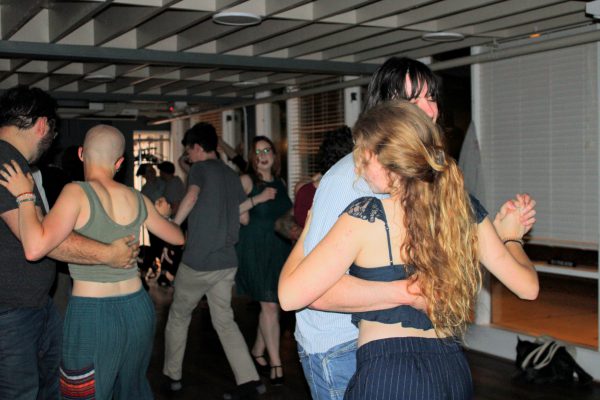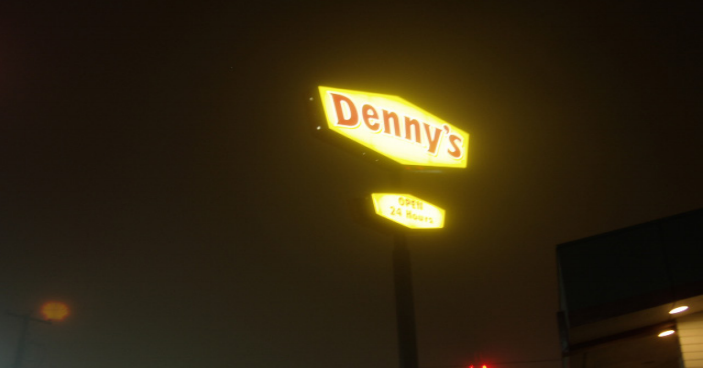Sophomore Editors Aiden Croghan and MJ Matthews dance alongside others to the soulful sound of blues.
McKenna Howenstine|Marlin Chronicle
Amid the hustle and bustle of Norfolk every Monday night, something magical happens. Smack dab in the middle of the quaint and quiet Botetourt Gardens, Tidewater Blues throws down to the sounds of the greats in blues music, as well as contemporaries. In the Fred Heutte Center, a rebuilt ferry terminal now standing in the middle of Norfolk, common barriers to entry for gatherings of this sort are taken care of.
The night begins with a beginner’s lesson on blues dancing, and Tidewater Blues operates on donations only, no cover fee. Supportive people combined with the connectedness of blues dance make this one of the most community-feeling spaces to be found in the Tidewater area.
Today’s thriving Tidewater Blues group is the product of many passionate volunteers and a community of blues enthusiasts that have been in retirement since the previous Hampton Roads group, Siren City Blues, came to a close. “A lot of the organizers who were like, ‘We want to bring blues back, they danced when there was something called Siren City Blues, and it was here. It was very nostalgic when we got back into the Fred [Huette Center] because we were just dancing out by the Pagoda when the weather was nice,” Savanna Baltero, an organizer for Tidewater Blues, said.
“A big part of what we do is maintaining blues dancing in Norfolk and around Hampton Roads and trying to support live music. We are trying to get more connected in the live blues music that’s around, and seeing what’s danceable […] because it would be so awesome to go in and blues-bomb places,” Baltero said.

Nick Griffiths (RIGHT) and Savanna Baltero (LEFT) help keep Tidewater Blues dancing with smiles on their faces.
McKenna Howenstine|Marlin Chronicle
It is evident how much care is put into making Tidewater Blues a mindful and inclusive space. “When I first started, it was kind of breaking through, where they were getting away from ‘men lead, women follow,’ and specifically trying to break that [gendered] language down,” Owl Motley, a longtime blues dancer and instructor at Tidewater Blues, said. “Nobody really knows that’s how it was supposed to be originally […] if you go to other dance styles, it’s still very regimented.”
“We’re creating space to create community, to have community, but also to learn about the history and to honor the history,” Baltero said.
Tidewater Blues emphasizes the roots of blues in their introduction to newcomers. “We also focus on the education side, understanding where blues came from and all of the history behind it,” Baltero said. She quoted bluesman Willie Dixon: “The blues are the roots and other music are the fruits.”
The evolution of Tidewater Blues from its predecessor blues group has brought many changes, but kept the same electric energy. “We’ve tried to make a conscious effort, especially over the past year or so, to really focus on traditional forms of Blues dancing and honoring the roots as a group — where this dance actually comes from, especially it being a dance that comes largely from African American culture,” Aaron Wright, a regular at Tidewater Blues, said.
Tidewater Blues embraces the many influences blues has had on music, so while dancing, you will hear traditional blues, along with jazz, fusion blues and even modern RnB.
It’s easy to fall into a comfortable step with those around you, and just as easy to find a reason to stay with it. “Dancing and being able to move your body is hugely important for me […] I tend to be pretty introverted in most other aspects of my life. This is a venue that helps me break out of my shell a bit, socialize and meet other people,” Wright said.
Though blues is a partnered dance, it can provide an outlet for self-expression. “The main thing I like about it is that the central thing about blues as a style is connection. It’s about dancing with the person that you’re partnered with and that’s a two-way kind of thing. In a lot of other dances, having a lead and follow designation is a lot more rigid. But in blues, when it’s working and functioning, both people keep their own style, they keep their own voices,” Joshua Simmons, who has been dancing with Tidewater Blues for nine months, said.
“I really like physical connection with people and this is a great way to do it –– sharing that kind of dance language with people,” Motley said. “It’s just really fun to dance with people.”
Dancing can also provide a moment of peace for people. “I come here not to think, I just listen to the music. I don’t think about what I’m doing, I just honor it,” Joshua Purnell, a longtime dancer at Tidewater Blues, said, comparing dancing to meditation.
Group instructor and volunteer organizer Nick Griffiths came to Virginia Beach looking for a blues group and found home with Tidewater Blues. “I came here, and I found that it was not only well established, but everybody here was kind and really engaged and loving it,” Griffiths said. “I just immediately dropped myself in.”
“Dance communities in particular live and die by their by the people that like prop them up,” Griffiths said. “It’s grassroots. Not a lot of people are really getting paid for this. It’s a labor of love, right?”
Griffiths’ admiration for the blues community is evident. “There’s just so much buy-in and love and care that goes into keeping this alive. You can’t help but see when you come in, everybody just really appreciates everybody here and wants to dance and make sure this project works,” Griffiths said. “And that’s just such a cozy, ooey, gooey, lovey feeling. That’s why I keep coming here week after week.”
While many of those dancing Monday night had a background in blues or Lindy Hop dancing, there were plenty of new dancers as well.
“This is one of the best, easiest places to fit in,” Motley said. “Just like with the music and diversity of dancing, there is a diversity of dancers.”
You can find Tidewater Blues at the Fred Heutte Center at 1000 Boutetort Gardens every Monday night. Beginner lessons start at 7 p.m., dancing starts at 8 p.m. — all are welcome.
By Aiden Croghan & MJ Matthews
accroghan@vwu.edu & mjmatthews@vwu.edu


